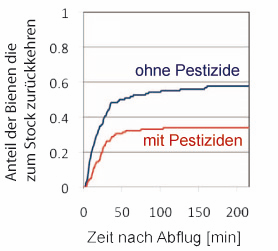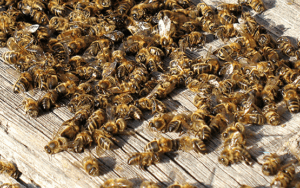Bee mortality has multiple causes and experts agree that pesticides is one of them. Many insecticides enter the metabolism of forager bees via the pollen and nectar. These bees bring take these substances with them into the beehive, where they contaminate stored food reserves and wax. We have collected the latest research on the effects of pesticides on bees. In this article we provide you with an overview of the current situation in Switzerland and the consequences for beekeeping.
Situation in Switzerland
For some years now, honeybees losses in winter have been up to 30% in certain regions of Switzerland. In the case of wild bees, as many as 45% of the 450 species studied are classified as endangered[1]. In short, the bees are doing poorly. But why? Experts agree that there is no simple answer to this question and that the causes are multiple. One of the causes which is affecting honey bees and wild bees alike, is pesticides. Pesticides usage has risen dramatically as result of the intensification of agriculture and the increased of large-scale monocultures. Over 2000 tons of pesticides are used in Switzerland (approx. 90% of which is used in agriculture).
Due to increasing resistance of pests, pesticide usage continues to rise, some crops are currently sprayed up to 30 times a year[2-3]. However, insecticides used for pest control are also toxic to bees. This applies in particular to the neonicotinoids thiamethoxam, clothianidin and imidacloprid which are in use since the 1990s[4]. Their use has been prohibited in Switzerland since 2013 for flowering crops and in the vicinity of flowering areas[5]. Nevertheless, these substances continue to cause bee poisoning every year[6]. Because the substances are absorbed by plants and stored in their pollen and nectar, the bees will inevitably get in contact with these toxic substances.
Effect on bees
The approval procedure for pesticides has so far taken only LD50 (the dose at which 50% of bees die) into account. For the neonicotinoids mentioned above, this is the lowest dose in the nano-range (20-80 ng for external contact and 4 ng for oral ingestion). However, research in recent years has shown various sublethal and synergistic effects that can occur with these dosages.
Sublethal Effects
Even small amounts of neonicotinoids can reduce the bees ability to learn and orient themselves. This leads to abnormal foraging behavior and a decreased communication ability[7-8]. A field trial carried out in 2012 showed that up to 30% of workers who foraged on a rapeseed field sprayed with thiamethoxam, did not find their way back to the hive (Figure 1). This worrisome result can lead to a sharp decline in the size of the bee population and can even lead to the collapse of the entire colony[9]. Additionally, small amounts of thiamethoxam is found to reducing the flight distance and duration by approx. 60% and the flight speed by approximately 10%[10].

Pesticides also find their way into the hive through the collected food sources, which are subsequently stored in the wax and fed to the brood via pollen bread. It could be shown that colonies with contaminated wax had an increased larvae mortality and a reduced life expectancy of the workers[11]. Further, thiamethoxam, has been shown to have a negative effect on queens. Queens which had contact with this neonicotinoid during their development, were smaller and had lower sperm quantities in their spermathecae after the wedding flight[12]. The neonicotinoid imidacloprid also reduces the breeding of new queens with as much as 85% by bumblebees[13]. The close relationship between bumblebees and honey bees suggests a similar effect on honey bees.
Synergistic effects
In addition to such sublethal effects, synergisms may also occur between different pesticides. Various fungicides which are normally harmless to bees, can increase the toxicity of insecticides. For example, the toxicity of the neonicotinoid acetamiprid increases up to a five times when combined with a fungicide[14]. A similar effect has been demonstrated with the insecticide lambda-cyhalothrin[15]. However, such synergisms are not taken into account in the approval procedure and both insecticides mentioned above may still be sprayed on flowering crops in Switzerland[5].
Importance for beekeeping
Choice of location
The risk of bee poisoning from pesticides is particularly high in agricultural areas with flowering crops that are attractive to bees, for example fruits and rapeseed. However, pesticides can also drift (when sprayed, the pesticides are blown away by the wind) to nearby areas. However in natural areas such as flower meadows and non-flowering crops, the risk of poisoning for bees is low. In addition, the use of pesticides in organic farming is much less compared with conventional farming, as organic farming uses only natural substances for pest control[16].
Precautionary measures
Pesticides can contaminate puddles and ponds in the vicinty of agricultural fields. Beekeepers located in the agricultural areas can reduce the risk of poisoning by providing their bees their own water source. In addition, dialogue with farmers can help raise their awareness of the dangers of pesticides. If the farmer informs the beekeeper when the pesticides is being sprayed, precautionary actions can be taken. For example by closing off the hive entrance the evening before spraying, this will prevent the bees from direct getting in direct contact with the pesticide.
List of all dangerous pesticides
Detection of bee poisoning
In cases of poisoning, masses of bees are lying dead in front of the hive entrance, mostly all colonies of the location will be affected. From April till August there is an increased risk of poisoning. High mortality rates outside this period are usually caused by diseases, in particular a high levels of varroa. In Switzerland, if poisoning is suspected, the bee health service must be informed immediately and a sample of dead bees should be sent over (more information). The documentation of poisoning cases is an important tool for assessing the risk of pesticides and can be used in further political decision-making.

Light at the end of the tunnel
Pesticides harm not just bees, but also various aquatic and soil organisms and disturb the natural ecological balance. The increase in yield that can be achieved by using pesticides is less than 15%. Often, pesticides are solely being used to meet the demands of visually perfect food. This little increase in yield does therefore not justify the use of pesticides. Especially since in Switzerland, around one third of produced food is lost due to food waste[3]. According to a study conducted in France, a 40% reduction in pesticide usage will not change farmers’ incomes. The losses due to the yield reduction are equivalent to the expenditure saved on pesticides[17].
This is why various organizations, including BienenSchweiz (the beekeeping association of german and romansh-speaking Switzerland), have long been calling for a reduction in the use of pesticides and better research into the risks. This has led to the adoption of the «Federal Action Plan for Risk Reduction and Sustainable Use of Plant Protection Products» in September 2017. Its key objective is to reduce the risks of plant protection products by 50% while taking into account the protection of non-target organisms, which among others also includes bees. To achieve this goal, the action plan pursues the further development and promotion of integrated pest management. This was developed in the 1970s and follows the principle that chemical agents are only used when preventive and non-chemical measures can no longer guarantee protection. In addition, research to improve the risk assessment of plant protection products and the development of alternatives will be supported. Also, the Centre for Bee Research has developed a standardized test to measure sublethal effects of pesticides. This test is used for risk assessments and is taken into account in the approval procedure for new pesticides[2].
Would you like to know more?
Pesticide Reduction Plan Switzerland
Action Plan for Risk Reduction and Sustainable Use of Plant Protection Products
Literature
1 Bericht des Bundesrates. Bericht zur Umsetzung des Nationalen Massnahmenplans für die Gesundheit der Bienen. (2016).
2 Bericht des Bundesrates. Aktionsplan zur Risikoreduktion und nachhaltigen Anwendung von Pflanzenschtzmitteln. (2017).
3 Vision Landwirtschaft. Pestizid-Reduktionsplan Schweiz – Aktuelle Situation, Reduktionsmöglichkeiten, Zielsetzungen und Massnahmen. (2016).
4 Sanchez-Bayo, F. & Goka, K. Pesticide Residues and Bees – A Risk Assessment. Plos One 9, doi:e9448210.1371/journal.pone.0094482 (2014).
5 Bundesamt für Landwirtschaft. Zugelassene Pflanzenschutzmittel. https://www.blw.admin.ch/blw/de/home/nachhaltige-produktion/pflanzenschutz/pflanzenschutzmittel/zugelassene-pflanzenschutzmittel.html.
6 Bienengesundheitsdienst. Bienenvergiftungen.
http://www.bienen.ch/de/themen/bienengesundheit/bienenvergiftungen.html.
7 Schneider, C. W., Tautz, J., Grunewald, B. & Fuchs, S. RFID Tracking of Sublethal Effects of Two Neonicotinoid Insecticides on the Foraging Behavior of Apis mellifera. Plos One 7, doi:e3002310.1371/journal.pone.0030023 (2012).
8 Thompson, H. M. & Maus, C. The relevance of sublethal effects in honey bee testing for pesticide risk assessment. Pest Management Science 63, 1058-1061, doi:10.1002/ps.1458 (2007).
9 Henry, M. et al. A Common Pesticide Decreases Foraging Success and Survival in Honey Bees. Science 336, 348-350, doi:10.1126/science.1215039 (2012).
10 Tosi, S., Burgio, G. & Nieh, J. C. A common neonicotinoid pesticide, thiamethoxam, impairs honey bee flight ability. Scientific Reports 7, doi:120110.1038/s41598-017-01361-8 (2017).
11 Wu, J. Y., Anelli, C. M. & Sheppard, W. S. Sub-Lethal Effects of Pesticide Residues in Brood Comb on Worker Honey Bee (Apis mellifera) Development and Longevity. Plos One 6, doi:e1472010.1371/journal.pone.0014720 (2011).
12 Gajger, I. T., Sakac, M. & Gregorc, A. Impact of Thiamethoxam on Honey Bee Queen (Apis mellifera carnica) Reproductive Morphology and Physiology. Bulletin of Environmental Contamination and Toxicology 99, 297-302, doi:10.1007/s00128-017-2144-0 (2017).
13 Whitehorn, P. R., O’Connor, S., Wackers, F. L. & Goulson, D. Neonicotinoid Pesticide Reduces Bumble Bee Colony Growth and Queen Production. Science 336, 351-352, doi:10.1126/science.1215025 (2012).
14 Biddinger, D. J. et al. Comparative Toxicities and Synergism of Apple Orchard Pesticides to Apis mellifera (L.) and Osmia cornifrons (Radoszkowski). Plos One 8, doi:e7258710.1371/journal.pone.0072587 (2013).
15 Pilling, E. D. & Jepson, P. C. Synergism between EBI fungicides and a pyrethroid insecticide in the honeybee (Apis mellifera) Pesticide Science 39, 293-297, doi:10.1002/ps.2780390407 (1993).
16 Bienengesundheitsdienst. Merkblatt Bienenvergiftungen. (2017).
17 INRA. Ecophyto R&D: which options to reduce pesticide use?http://institut.inra.fr/en/Objectives/Informing-public-policy/Advanced-Studies/All-the-news/Ecophyto-R-D (2010).